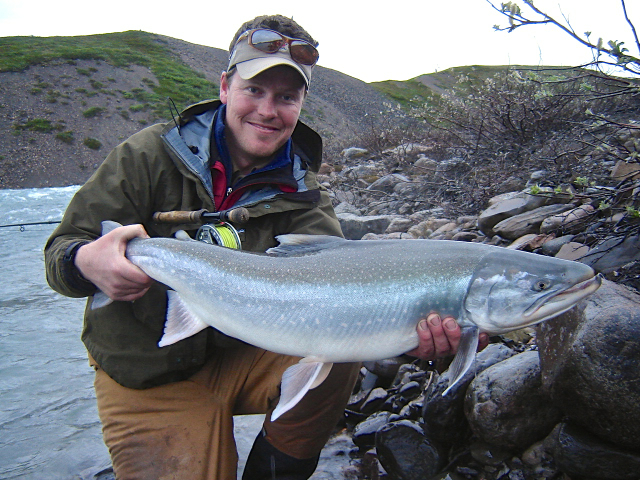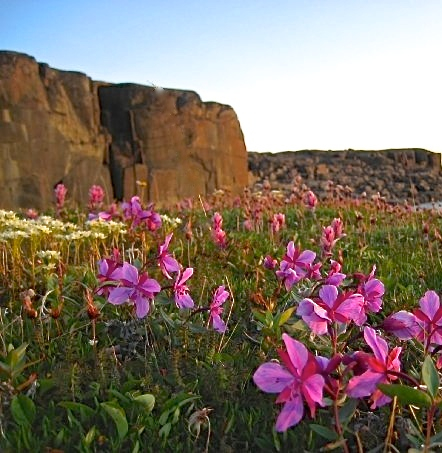Fishing the Kogluktualuk
![]() Written by
Harold
Written by
Harold
- Published in The Fishing
- Read 10514 times
- font size decrease font size increase font size
Following the two-hour flight across the spectacular Arctic Barren Lands, our Turbo Otter glided onto the river just below the Plummer’s Arctic Lodges, Tree River Camp.
After transferring into boats, we made the short run upstream to the camp, where we were greeting at the small wooden dock by the camp cook.

Once greetings had been exchanged, we were ushered into the cookhouse, and served up steaming hot bowls of homemade beef stew, together with a plate of fresh, warm cheese biscuits that were so light, if not for the towel draped over them, would have likely floated out of the window.
This was the quintessential outpost cookhouse featuring long wooden tables, bench seats, and the standard cluster of condiments including ketchup, Heinz 57 Sauce, HP Sauce, Tabasco and of course, a container of toothpicks.
There were plastic jugs filled with water and juice, together with heavy white mugs that would eventually be filled with hot coffee to help wash down the cookies that had just been taken out of the oven.
The cookhouse is one of several small white buildings at the base of the rivers’ first set of rapids that make up Plummer’s’ Tree River Camp. There are also warm, comfortable guest cabins, privies, showers and the famous, although infrequently visited Kogluktualuk Store.

When you first see the cluster of buildings from the air, they look more like a small flock of white sheep than an outpost camp.
Together with being a place of great natural beauty, and monster Char the Tree River area is rich in Inuit history, including a tragic incident involving the murder of two RCMP constables back in 1922.
As the story goes, Hudson’s Bay Company employee, and RCMP Special Constable Otto Binder, together with RCMP Corporal, Andrew Doak were murdered by an Inuit named Alikomiak on April 1,1922, at the small RCMP Station located at the mouth of the Tree - or as it was known then - Port Epworth.Corporal Doak had recently arrested Alikomiak, and his accomplice Tatimagana on suspicion of having murdered four Inuit at the Coronation Gulf in August 1921, apparently because of a dispute over a woman.

These men were the first Inuit tried, condemned, and executed by hanging under Canadian Law, and the gallows used to hang them, which were located in Pauline Cove on Herschel Island, remained standing well into the 1950’s.
As mentioned, the Tree is noted for producing the biggest Arctic Char in the world. The people who are paid good money to study things of this nature, have commented that the Char in this river “...are notable for lessened genetic variability,” or in other words, the fact they don’t have too many forks in their family tree explains, at least in part, why they are so big.

Four of our six-person group headed upstream from camp, and after being shuttled across the river in two beat up old aluminum boats, on the advice of our guide Craig Blackie, my partner and I began fishing from shore just above the first rapid. After catching several fish, we hopped back into the boat and moved into the main river channel, establishing a drift from the base of the second rapid, to just above the first set.
The drift proved to be very productive, and by the time the dinner bell rang, the four of us had caught and released twenty-one Char, ranging in size from fifteen pounds, up to a rather remarkable twenty-six pounder. Those who chose to fish down stream from camp came up with two char in the twelve to fifteen pound range.
Our fish were caught using a ⅞ ounce Pixie with a fluorescent red insert. The most productive pattern was to cast upstream, and allow the Pixie to sink and tumble along the bottom while being propelled by the current. As Craig pointed out, if we didn’t get hung up on every third or fourth cast, we were not fishing deep enough.

After dinner, we walked down stream a short distance from camp to try our luck in small stream that feeds into the main river.
I decided to switch over to a fly rod, and tied on a red and white rabbit hair streamer. While my first cast became firmly embedded in a trophy size scrub willow, a twelve-pound char hammered my second offering.
We then moved upstream to fish a small narrow run embedded within the second set of rapids. On my second cast, using the same red and white streamer, another fish was on, and after an incredible, and somewhat exhausting battle that lasted more than twenty minutes; we landed and released a beautiful fifteen pounder.
Handing the rod to my guide so I could give my arms a bit of a rest, Craig caught a twelve pounder on his first cast.
The next day we decided to take a break from fishing, and floated downstream to do a bit of sightseeing.
We dipped our feet in the Arctic Ocean, visited the gravesites of Otto Binder and Corporal Doak, checked out an Inuit fishing camp, and just otherwise enjoyed the spectacular scenery along this beautiful Arctic river.
The others fished above the first rapid and managed to catch two more fish, bringing our overall total to twenty seven char, none of which weighed less than ten pounds.
If you ever have the privilege to visit the Tree River – prepare to be amazed.
Your trip to and from the river will take you across the magnificent Barren Lands with all its rugged beauty, and the scenery along the river is stunning in its own right.
We were treated to sightings of Wolves, Muskoxen, Tundra Swans, Golden Eagles, Peregrine Falcons, and marveled at the millions of tiny, bright, colorful flowers and lichens that seemed to illuminate the tundra.

The walk up river to what are known as the “third falls” is worth the price of admission alone, and if you take the hike, make sure that your camera has an extra large memory card with plenty of space on it.

You will catch the biggest Arctic Char in the world, and when all is said and done, hopefully it will leave you with lasting memories of what in my opinion is one of most beautiful places this planet has to offer.









